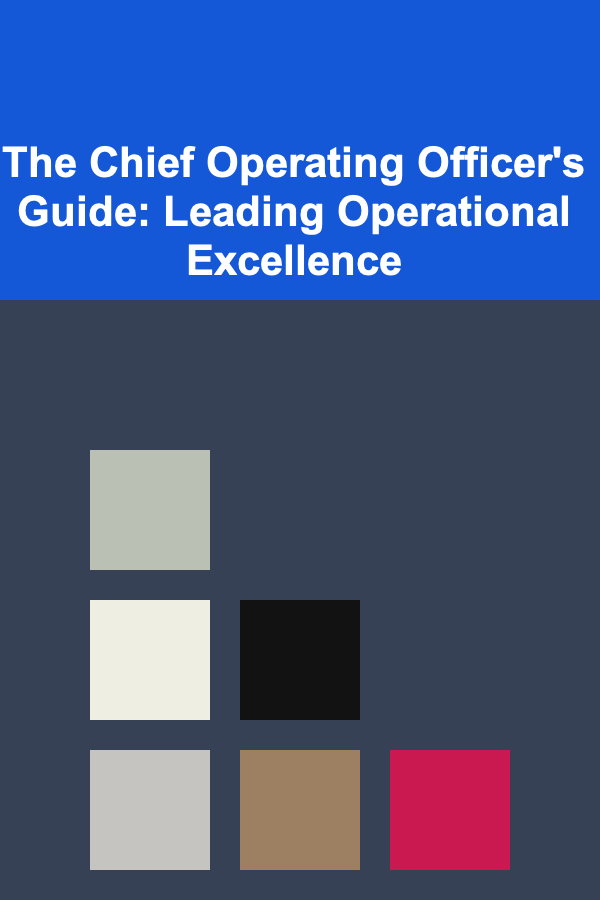
The Chief Operating Officer's Guide: Leading Operational Excellence
ebook include PDF & Audio bundle (Micro Guide)
$12.99$8.99
Limited Time Offer! Order within the next:

In today's competitive business environment, the role of the Chief Operating Officer (COO) is more critical than ever. While the COO's responsibilities have traditionally been centered around managing day-to-day operations, the modern COO is tasked with ensuring operational excellence, fostering innovation, and driving long-term organizational success. This guide dives deep into how COOs can lead operational excellence within their companies, from aligning operations with strategic goals to managing cross-functional teams and embracing data-driven decision-making.
The Essence of Operational Excellence
Operational excellence is the philosophy of improving efficiency, effectiveness, and quality across every facet of an organization's operations. For the COO, it means ensuring that all business processes---whether in production, customer service, or logistics---run smoothly, efficiently, and effectively, contributing to both short-term performance and long-term growth.
But operational excellence is not just about reducing costs or increasing output. It's about creating a culture that continually improves and adapts to changing circumstances. COOs are responsible for fostering this culture, implementing systems that optimize operations, and making data-driven decisions that guide the organization toward sustainable success.
Key Responsibilities of the COO in Operational Excellence
1. Aligning Operations with Business Strategy
The first critical responsibility of the COO is ensuring that the organization's operations are aligned with its broader business strategy. This involves translating high-level strategic goals into actionable operational plans.
Actionable Steps:
- Understand Strategic Priorities: The COO must have a deep understanding of the company's long-term goals. Whether it's expanding into new markets, increasing product lines, or improving customer satisfaction, the COO must ensure that operations directly contribute to these goals.
- Break Down Strategic Goals into Operational Tasks: Once strategic priorities are clear, the COO should develop actionable plans at the operational level. For instance, if the strategy is to expand internationally, the COO might focus on building scalable systems and processes that can support global growth.
- Regularly Review and Adjust: The business landscape is constantly shifting. COOs must conduct regular reviews to assess the alignment between operations and strategy, adjusting tactics as needed to ensure the organization stays on track.
2. Streamlining Processes for Efficiency
One of the hallmark responsibilities of the COO is ensuring that operations are streamlined for maximum efficiency. This includes identifying inefficiencies, reducing waste, and making continuous improvements.
Actionable Steps:
- Implement Lean Principles: Lean methodologies focus on eliminating waste and improving efficiency. COOs can apply lean principles across various business units to ensure resources are used effectively and that unnecessary steps are eliminated from workflows.
- Automate Where Possible: Automation is an essential tool for improving efficiency. The COO should invest in tools that automate repetitive tasks, freeing up employees to focus on higher-value activities. Technologies like Robotic Process Automation (RPA) and machine learning can help businesses streamline their operations.
- Standardize Processes: Standardizing workflows and creating documented procedures help improve consistency and reduce the potential for errors. This is particularly important as companies scale, ensuring that each department works according to best practices.
- Focus on Continuous Improvement: Operational excellence is not a one-time effort. The COO should foster a culture of continuous improvement where employees are empowered to suggest process optimizations and improvements.
3. Leading Cross-Functional Collaboration
Effective operations require collaboration across all departments, from sales and marketing to finance and HR. The COO plays a vital role in breaking down silos and ensuring that teams work cohesively toward shared goals.
Actionable Steps:
- Encourage Open Communication: One of the primary barriers to effective collaboration is poor communication. The COO must establish clear channels for communication and ensure that teams across the company understand each other's roles and objectives.
- Promote Shared Goals: By aligning cross-functional teams around shared business objectives, the COO ensures that each department understands how its work contributes to the company's overall success. For example, sales and production teams must collaborate closely to ensure that demand forecasts align with manufacturing capabilities.
- Foster a Team-Oriented Culture: COOs should create an environment where collaboration is rewarded, and employees feel comfortable working together to solve problems and innovate. Regular team-building activities and cross-departmental projects can help build stronger relationships across functions.
4. Leveraging Data for Operational Decision-Making
The use of data is perhaps one of the most significant drivers of operational excellence. By leveraging data analytics, COOs can make more informed decisions, identify trends, and predict outcomes with greater accuracy.
Actionable Steps:
- Implement a Robust Data Infrastructure: The COO must ensure that the organization has the necessary infrastructure to collect, store, and analyze data. This includes investing in data management tools and business intelligence (BI) platforms like Power BI, Tableau, or Google Analytics.
- Use Real-Time Data for Decision-Making: In an era of rapid change, real-time data is essential for making quick, informed decisions. COOs should implement systems that provide up-to-the-minute data on operational performance, allowing leaders to act swiftly when needed.
- Establish Key Performance Indicators (KPIs): The COO should define key metrics that measure operational success, such as production efficiency, customer satisfaction, and employee performance. Monitoring these KPIs helps identify areas for improvement and drives performance.
- Predictive Analytics: Predictive analytics can help COOs foresee potential challenges or opportunities in the operational landscape. For example, by analyzing historical sales data, predictive models can forecast demand fluctuations and help adjust inventory levels accordingly.
5. Cultivating a Culture of Innovation
Operational excellence is not just about efficiency; it's also about fostering a culture of innovation. COOs need to ensure that the organization is constantly evolving, adapting, and finding new ways to create value for customers.
Actionable Steps:
- Support Idea Generation: COOs should encourage a culture where innovation is celebrated and new ideas are welcomed. This can be achieved through structured brainstorming sessions, innovation labs, or internal competitions.
- Test and Scale New Ideas: Rather than being risk-averse, COOs should create an environment where employees are encouraged to test new ideas. These ideas should be piloted in small-scale projects and, if successful, scaled across the organization.
- Invest in Emerging Technologies: The COO should stay ahead of the curve when it comes to new technologies that could improve operational efficiency. Technologies like AI, automation, and blockchain can drive innovation and improve operational performance across the business.
- Encourage Cross-Departmental Innovation: Innovation often happens at the intersection of different disciplines. COOs should encourage departments to collaborate on new solutions that address company-wide challenges, fostering innovation in both products and processes.
6. Managing Risk and Crisis Situations
Even with the best-laid plans, operational risks are inevitable. Whether it's a supply chain disruption, economic downturn, or technological failure, the COO must be prepared to manage crises effectively while ensuring minimal impact on operations.
Actionable Steps:
- Develop Contingency Plans: The COO should work with other leaders to develop comprehensive contingency plans for various scenarios, such as natural disasters, cybersecurity breaches, or vendor failures. These plans should outline specific actions and responsibilities to ensure the company can respond quickly and effectively to crises.
- Risk Mitigation Strategies: COOs must assess the company's vulnerabilities and put strategies in place to mitigate risk. This may involve diversifying suppliers, implementing cybersecurity measures, or creating financial buffers to weather economic downturns.
- Maintain Business Continuity: In the event of a disruption, the COO should ensure business continuity by establishing backup processes and maintaining emergency protocols. This can include remote working plans, backup data systems, and alternative supply chain routes.
The Path to Operational Excellence
Achieving operational excellence is a journey, not a destination. It requires constant evaluation, adaptation, and improvement. For the modern COO, this means staying agile, being proactive in addressing challenges, and always looking for ways to optimize every aspect of the organization.
By aligning operations with strategic goals, fostering innovation, leveraging data, and building a culture of continuous improvement, the COO can drive operational excellence and create long-term value for the organization. Ultimately, operational excellence isn't just about making processes better---it's about creating an organization that is resilient, agile, and ready to thrive in an ever-changing business environment.
Reading More From Our Other Websites
- [Screen Printing Tip 101] Exploring Specialty Inks: Metallic, Neon, and Discharge Methods for Standout Prints
- [Home Family Activity 101] How to Create a Family Reading Ritual with Books for All Ages
- [Home Storage Solution 101] How to Create a Decluttered Bedroom with Storage Solutions
- [Home Cleaning 101] How to Properly Wash and Store Your Bedding
- [Home Party Planning 101] How to Plan a Holiday-Themed Party for Any Occasion
- [Home Staging 101] How to Price Your Home Staging Services: Understanding the Value of Your Salary and Skills
- [Personal Investment 101] How to Invest in Bonds and Understand Their Risks
- [Home Cleaning 101] How to Clean Your Walls and Baseboards Easily
- [Home Security 101] How to Install a Home Security System on Your Own
- [Organization Tip 101] How to Use Ladder Stabilizers for Uneven Ground: A Safety Guide

How to Declutter Your Home Effectively Before Staging
Read More
How to Make a Checklist for Editing for Cultural Sensitivity
Read More
How to Soundproof a Shared Wall in a Townhouse or Condo
Read More
How to Store Your Sports Gear Efficiently in Limited Space
Read More
How to Identify the Impact of Oak Aging on Wine
Read More
Grasping the Principles of Battery as a Service (BaaS)
Read MoreOther Products

How to Declutter Your Home Effectively Before Staging
Read More
How to Make a Checklist for Editing for Cultural Sensitivity
Read More
How to Soundproof a Shared Wall in a Townhouse or Condo
Read More
How to Store Your Sports Gear Efficiently in Limited Space
Read More
How to Identify the Impact of Oak Aging on Wine
Read More